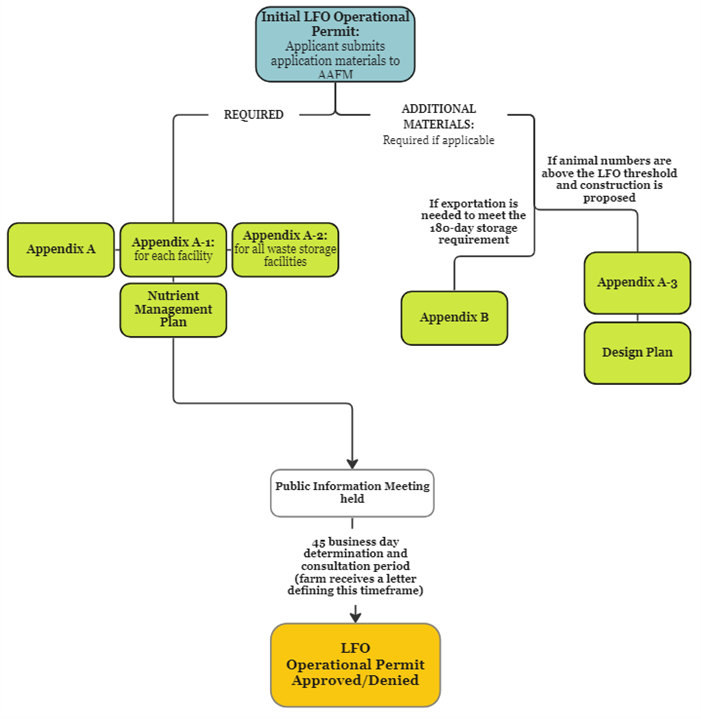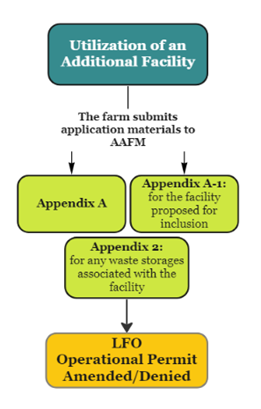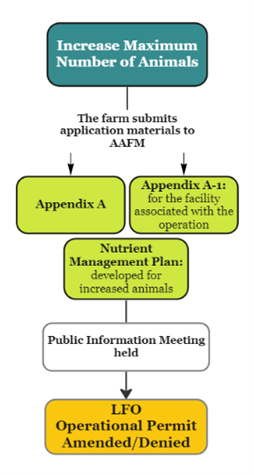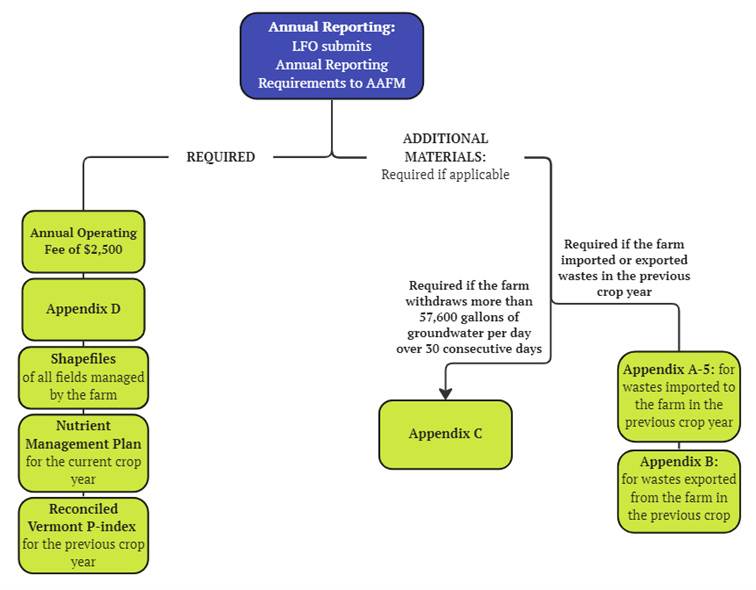- Introduction to the LFO Program
- LFO Definition
- Application Process for an Initial LFO Permit
- Amendment Application Processes
- Construction Permit Application Process
- Informational Meetings
- Annual Reporting and Operating Fee Requirements
- Contact
Downloadable Documents & Helpful Links
LFO Permit Application Materials
- LFO Individual Permit Application - Appendix A: Application for Large Farm Operation Permit
- LFO Permit Application - Appendix A-1: Facility Information Form
- LFO Permit Application - Appendix A-2: Waste Storage Facility (WSF) Form
- LFO Permit Application - Appendix A-3: Proposed Construction Form (submit one for each proposed structure)
- LFO Permit Application - Appendix A‐6: Transfer of Ownership Form
- LFO Notice of Termination
Annual Reporting Forms
- LFO Permit Application - Appendix B: Agricultural Waste Export Agreement Form
- LFO Permit Application - Appendix C: Water Withdrawal and Use Report
- LFO Permit Application - Appendix D: Annual Compliance Report
Helpful Links
- Required Agricultural Practices
- LFO Program Rules
- NRCS Nutrient Management Plan 590 Standard
- Farms Permitted as Large Farm Operations
The Large Farm Operation (LFO) Program was created in 1995 and is designed to ensure that Vermont LFOs have implemented land management and production area practices to prevent the direct discharge of nutrients into Vermont waterways. The program's requirements exceed those of the Federal Clean Water Act with the goal of reducing the amount of phosphorus and other nutrients accumulating in State waterbodies.
The program requires farms meeting the LFO definition to operate under an individual LFO permit. An LFOs individual permit is specific to each permitted LFO, establishes regulatory requirements regarding the management of agricultural wastes and prohibits the direct discharge of waste into state waters. Unless otherwise given notice by the Agency, all LFOs in the state of Vermont are required to operate under the coverage of an individual permit. LFO individual permits are valid until amended or terminated.
A person shall apply for an LFO permit from the Agency when:
- operating a farm with animals exceeding the LFO livestock threshold where the animals have been, are, or will be stabled or confined and fed or maintained for a total of 45 days or more in any 12-month period, and
- the livestock are in a barn or adjacent barns operated by the same person;
- the barns share a common border; or
- share a waste management system.
- constructing a new barn, or expanding an existing barn, designed to house more than the LFO livestock thresholds.
LFO livestock thresholds:
- 700 mature dairy cows, whether milked or dry;
- 1,000 veal calves;
- 1,000 cattle other than mature dairy cows or veal calves. Cattle includes but is not limited to heifers, steers, bulls and cow/calf pairs;
- 2,500 swine each weighing 55 pounds or more;
- 10,000 swine each weighing less than 55 pounds;
- 500 horses;
- 10,000 sheep or lambs;
- 55,000 turkeys;
- 30,000 laying hens or broilers with a liquid manure handling system;
- 125,000 chickens (other than laying hens) without a liquid manure handling system;
- 82,000 laying hens without a liquid manure handling system;
- 30,000 ducks without a liquid manure handling system; or
- 5,000 ducks with a liquid manure handling system.
- any other animal type and number that the Secretary may deem to fit this category
LFOs must to adhere to the Required Agricultural Practices, Large Farm Operation Rules, and the conditions of their individual permits at all times.
Application Process for an Initial LFO Permit
To apply for an initial LFO Permit, the following application materials must be submitted to AAFM by the applicant:
- Appendix A: Application for Large Farm Operation Permit
- Appendix A-1: Facility Information Form: for each facility housing animals associated with the application
- Appendix A-2: Waste Storage Facility Form: for each waste storage facility associated with the application
- Nutrient Management Plan (NMP): developed by a certified nutrient management planner or the applicant in accordance with the NRCS VT590 Standard.
The following application materials may also be required, if applicable:
- Appendix A-3: Proposed Construction Form: for the construction or expansion of animal housing or a waste storage facility if the applicant is already above the LFO threshold at the time of application or constructing a new barn, or expanding an existing barn, designed to house more than the LFO livestock thresholds.
- Appendix B: Agricultural Waste Export Agreement Form: if the applicant plans to export waste as part of their waste management system to meet the 180-day waste storage requirement.


Amendment Application Processes
Utilization of an Additional Facility - to apply to amend an existing permit to include an additional facility, an LFO must submit to the Agency:
- Appendix A: Application for Large Farm Operation Permit
- Appendix A-1: Facility Information Form: for each facility associated with the application
- Appendix A-2: Waste Storage Facility Form: for each waste storage facility associated with the application
Only the Appendix A-2: Waste Storage Facility form is required if the permittee is amending an existing permit to include a waste storage facility and not animal housing.

Increase Maximum Number of Animals – to apply to amend an existing permit to increase the authorized maximum number of animals, an LFO must submit to the Agency:
- Appendix A: Application for Large Farm Operation Permit
- Appendix A-1: Facility Information Form: for each facility associated with the application
- Nutrient Management Plan (NMP): developed for the proposed increased number of animals by a certified nutrient management planner or the applicant in accordance with the NRCS VT590 Standard
- Additional application materials requested by the Agency when applicable.

Transfer of Ownership - to transfer permit ownership with the sale or lease of an LFO the farm must submit to the Agency an Appendix A-6: Transfer of Ownership form.
Relinquishment of an LFO Permit - an LFO may request to relinquish their LFO Permit by submitting a Notice of Termination form when:
- A permittee ceases operation
- When a permittee’s number of animals fall below the LFO threshold number of animals.
AAFM may ask the permittee for additional information to verify animal numbers.
Construction Permit Application Process
Construction or Expansion of Animal Housing or a Waste Storage Facility - to apply to construct or expand animal housing or a waste storage facility, an LFO must submit to the Agency:
- Appendix A-3: Proposed Construction Form: for all proposed construction and expansion, and
- A construction design plan with dimensions and applicable setbacks.
- Prior to construction, the LFO must also:
- notify the town zoning administrator or the town clerk, in writing, of the proposed construction prior to beginning any construction activity, and
- consult with the ANR Department of Environmental Conservation (DEC) Watershed Management Division to determine whether a Construction Stormwater Discharge Permit, Flood Hazard and River Corridor General Permit, Wetlands Permit, or other permits are required prior to beginning construction.

Construction Extension - to apply for an extension to approved construction, an LFO must:
- submit a written request for an extension, and
- if the project has changed since the initial approval, submit an updated Appendix A-3: Proposed Construction form and an updated design plan.
Informational Meetings
Public Information Meeting (PIM)
AAFM policy requires a PIM for:
- applicants seeking an initial LFO operational permit,
- construction or expansion of animal housing,
- increasing permitted maximum number of animals,
- construction of a waste storage facility outside of an existing production area, and
- construction extension request submitted 4 years after initial construction approval.
AAFM policy may require a PIM for:
- construction or expansion of a waste storage facility within a production area,
- expansion of a waste storage facility outside of the production area, and
- on a case-by-case basis at the Secretary’s determination.
Advisory Group Meeting
The AAFM requires an Advisory Group Meeting for a New Large Farm Barn. A New Large Farm Barn is a proposed barn designed to house more than the LFO livestock threshold and is constructed where no animal housing infrastructure currently exists.
The AAFM may require an Advisory Group Meeting for the expansion of an existing barn so that it is capable of housing animals greater than the LFO livestock threshold.
Annual Reporting and Operating Fee Requirements
Permitted LFOs must submit annual reporting requirements by February 15 of each year.
Annual operating fee of $2,500
- Checks should be made payable to Vermont Agency of Agriculture, Food & Markets and sent to: VAAFM // Attn Jeff Cook // 116 State Street // Montpelier, VT 05620
Annual Reporting Requirements:
- Required submissions:
- Appendix D: Annual Compliance Report
- Current NMP in accordance with the NRCS VT590 Standard
- Shapefiles of all fields managed by the LFO
- Reconciled Vermont P-index of the previous crop year for any fields where deviation occurred (e.g. a different crop was grown than what was planned in the NMP, fertilizer and/or manure applications exceeded recommendations in the NMP, etc). The only exception is when the nutrient applications were less than the planned rates if the crop grown matched the planned crop in the NMP.
- Additional forms/information, if applicable:
- Appendix B: Agricultural Waste Export Agreement Form: if the permittee exported any wastes in the previous crop year.
- Appendix C: LFO Water Withdrawal and Use Report - if the LFO withdraws more than 57,600 gallons of groundwater per day averaged over any 30 consecutive-day period.
- Additional requests from the Secretary for compliance review.

Contact
Statewide Permitting and Nutrient Management Staff
- Brittany Cole: (802) 522-7413 l Brittany.Cole@vermont.gov
Regional Farm Coordinator Contact Information

